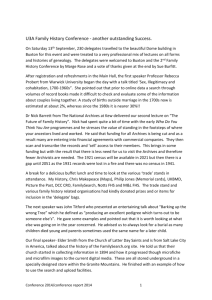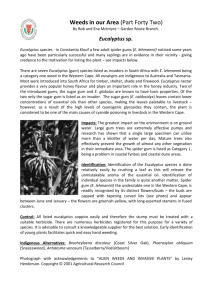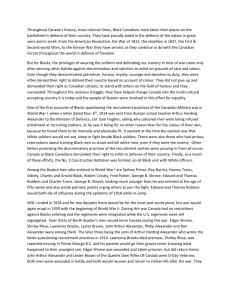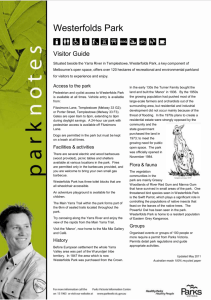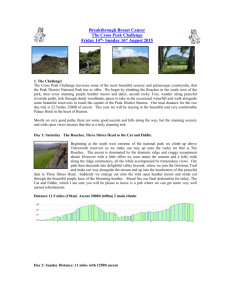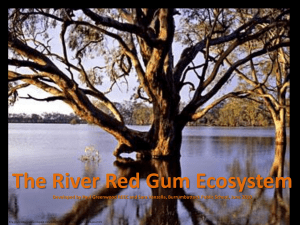Buxton Gum (Eucalyptus crenulata) accessible
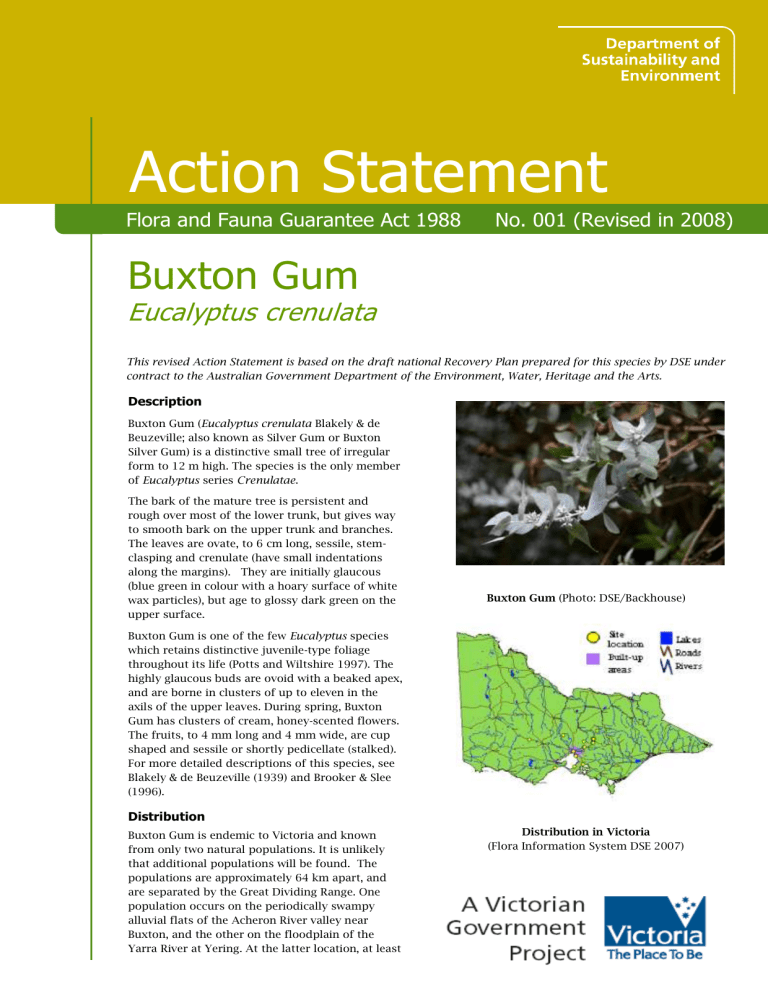
Action Statement
Flora and Fauna Guarantee Act 1988 No. 001 (Revised in 2008)
Buxton Gum
Eucalyptus crenulata
This revised Action Statement is based on the draft national Recovery Plan prepared for this species by DSE under contract to the Australian Government Department of the Environment, Water, Heritage and the Arts.
Description
Buxton Gum (Eucalyptus crenulata Blakely & de
Beuzeville; also known as Silver Gum or Buxton
Silver Gum) is a distinctive small tree of irregular form to 12 m high. The species is the only member of Eucalyptus series Crenulatae.
The bark of the mature tree is persistent and rough over most of the lower trunk, but gives way to smooth bark on the upper trunk and branches.
The leaves are ovate, to 6 cm long, sessile, stemclasping and crenulate (have small indentations along the margins). They are initially glaucous
(blue green in colour with a hoary surface of white wax particles), but age to glossy dark green on the upper surface.
Buxton Gum is one of the few Eucalyptus species which retains distinctive juvenile-type foliage throughout its life (Potts and Wiltshire 1997). The highly glaucous buds are ovoid with a beaked apex, and are borne in clusters of up to eleven in the axils of the upper leaves. During spring, Buxton
Gum has clusters of cream, honey-scented flowers.
The fruits, to 4 mm long and 4 mm wide, are cup shaped and sessile or shortly pedicellate (stalked).
For more detailed descriptions of this species, see
Blakely & de Beuzeville (1939) and Brooker & Slee
(1996).
Distribution
Buxton Gum is endemic to Victoria and known from only two natural populations. It is unlikely that additional populations will be found. The populations are approximately 64 km apart, and are separated by the Great Dividing Range. One population occurs on the periodically swampy alluvial flats of the Acheron River valley near
Buxton, and the other on the floodplain of the
Yarra River at Yering. At the latter location, at least
Buxton Gum (Photo: DSE/Backhouse)
Distribution in Victoria
(Flora Information System DSE 2007)
some of the mature Buxton Gums are thought to be hybrids between Eucalyptus crenulata and
Swamp Gum (Eucalyptus ovata) (Adams & Simmons
2000), and the characteristics of individual trees may not be entirely consistent with the species description in the botanical literature (Blakely & de
Beuzeville 1939). Throughout this document the name E. crenulata or Buxton Gum will be used to refer to both ‘pure’ breeding Eucalyptus crenulata and hybrids.
Abundance
Eucalyptus crenulata is rare both in terms of abundance and distribution. There are only two wild populations, which together occupy an area of less than 10 ha. Fewer than 700 individuals remain in the wild, and the species is likely to have been naturally rare prior to European settlement.
Important populations
The Buxton population is comprised of three small sub-populations, which were presumably part of a more or less continuous distribution of the species in the area. These sub-populations are now isolated from one another by cleared pasture.
The largest of these isolates comprises approximately 600 individuals (Adams & Simmons
2000) and covers about 4 ha of the 16.9 ha Buxton
Silver Gum Reserve (which is managed by Parks
Victoria). The other smaller sub-populations are on freehold land. One sub-population consists of nine scattered trees on grazed land immediately adjacent to the reserve (sub-population B), and the other contains fewer than 50 individuals within a small remnant of vegetation approximately 0.5 km distant (sub-population C).
The second population consists of approximately eight mature trees scattered over 4 ha on Spadoni’s
Nature Conservation Reserve at Yering near the confluence of Olinda Creek and the Yarra River; this site is managed by Parks Victoria. The remaining individuals of the original population of
Buxton Gum at this location are on freehold land.
Numerous individuals have been established through planting of tube-stock on the adjacent
Spadoni’s Recreation Reserve which is managed by the Shire of Yarra Ranges.
Buxton Gum is an attractive tree and is commonly grown as an ornamental across south-eastern
Australia. There are now far more individuals of this species in cultivation than in the wild. Buxton
Gum is naturalised at a number of locations outside its natural range, notably at Flowerdale
(Victoria), but also as far afield as the Southern
Tablelands of NSW (Carr 1993; Geoff Carr, Ecology
Australia Pty. Ltd. pers. comm.).
Habitat
The Yering population is situated on the floodplain of the Yarra River. The soils are deep alluvial loams, and the general topography is flat with scattered, periodically inundated depressions.
Dominant associated overstorey species include
Swamp Paperbark (Melaleuca ericifolia), Swamp
Gum (Eucalyptus ovata) and Manna Gum (E.
viminalis). Common Tussock-grass (Poa
labillardieri), and introduced pasture grasses and herbs (Adair 1978), dominate the understorey.
Other notable plant species at the site include
Poison Rice-flower (Pimelea pauciflora) which is rare in Victoria (Rosengren et al. 1983, Ross 2000).
The site has been partially cleared for pasture, and significant alterations have been made to the drainage patterns across the floodplain.
At Buxton, E. crenulata occupies a poorly drained hollow on the alluvial terraces adjacent to the
Acheron River. The site is an open forest dominated by Swamp Gum (Eucalyptus ovata) with
Mountain Swamp Gum (Eucalyptus camphora) on the wettest sites and Narrow-leaf Peppermint (E.
radiata) on the drier raised areas. Eucalyptus
crenulata occurs as an understorey tree beneath E.
ovata, but is the dominant overstorey species in a particularly waterlogged area. The relief is low and the soils are predominantly stiff clays derived from the weathering of Devonian marine sediments. The site is botanically rich and unusual. Of particular interest is the preponderance of Button Grass (Gymnoschoenus
sphaerocephalus) and Sphagnum Moss (Sphagnum sp.) in the understorey of the poorly drained parts of the reserve (Carr 1978 and M. White unpublished data). An outlying stand (subpopulation C) in the Buxton area occurs as an understorey tree in a remnant stand of Eucalyptus
ovata which occupies a broad swampy drainage line.
Life history and ecology
Apart from a limited number of preliminary studies (notably Simmons & Parsons 1976 and
Adams & Simmons 2000), little is known of the biology and ecology of Eucalyptus crenulata.
Information has largely been gleaned from field observations, site inventories, qualitative monitoring and the horticultural performance of the species.
Conservation status
National conservation status
Buxton Gum is listed as endangered under the
Commonwealth Environment Protection and
Biodiversity Conservation Act 1999.
Victorian conservation status
Buxton Gum is listed as threatened under the
Victorian Flora and Fauna Guarantee Act 1988.
2
It is considered endangered in Victoria according to DSE’s Advisory List of Rare or Threatened Plants
in Victoria – 2005 (DSE 2005).
Decline and threats
Eucalyptus crenulata has declined in range and abundance over the past 150 years due to land clearing for agriculture. Evidence for its decline through clearing at both Yering and Buxton is largely anecdotal. However, Pryor (1981) noted that the species had disappeared from several sites where it was previously recorded, and Willis (1972) noted the destruction of individual trees at the
Buxton site. There is no evidence that the species existed in the wild at locations other than Yering and Buxton. Although deliberate clearing of wild E.
crenulata has not been documented or observed in the last 25 years, the construction of a walking track at Buxton in the 1970s probably resulted in the loss of some individuals. Recent studies of aerial photography from 1952 to the present indicate that the area occupied by E. crenulata at
Buxton has not decreased significantly over the last 50 years (Adams & Simmons 2000).
Buxton Gum is vulnerable to threats that may result in the loss of wild populations in the future.
Both remaining populations are extremely localised, and are susceptible to weed invasion and other catastrophic events such as disease and wildfire. In addition, altered disturbance regimes may have impaired the ability of the species to effectively recruit new adult plants. Of acute concern at Buxton is the presence of the pathogenic soil-borne Cinnamon fungus
(Phytophthora cinnamomi) (Adams & Simmons
2000) and an infestation by the twining hemiparasitic plant, Coarse Dodder-laurel (Cassytha
melantha). At Yering, the site has been grossly modified by past land use, river regulation and floodplain works. It is unlikely that the array of environmental parameters that maintained a selfsustaining population of E. crenulata at this site are still extant.
Poor health
Moderate – Although many plants have exhibited poor health, no mortalities have resulted as yet.
Weed invasion
High – Serious environmental weeds are present at both sites.
Potential threats/perceived risk
Grazing
High – On private land sites if grazing continues.
Lack of recruitment
Moderate – If mature trees senesce and recruitment of juveniles still does not occur.
Hybridisation and genetic issues
High – Particularly if the frequency of hybridisation increases at the Buxton Silver Gum
Nature Conservation Reserve.
Previous management action
Buxton
2000 - Health, recruitment and survival baseline monitoring set up and data collected
(Threatened Species Network Grant).
2000 - Small trial set up to measure response of individual Buxton Gums to physical removal of
Dodder Laurel.
2000 – 2003 - Revegetation of open area adjacent to the Buxton gum population.
Approximately 1.5 ha planted with Buxton Gum and other local indigenous over-storey species.
Planting completed by Parks Victoria and various community groups.
2001 - Information board updated at the reserve.
2003 - Public access walk upgraded to Acheron
River and steps taken to discourage use of the walkway within the Buxton Gum population.
Current threats/perceived risk
Hybridisation and genetic issues
High - There are a number of potential genetic consequences of population decline, isolation and fragmentation.
Environmental factors leading to a lack of recruitment
High - The Yering site is subject to gradual environmental degradation.
Spadoni’s Reserve
Weeds are controlled annually.
Fence has been repaired.
Monitoring is ongoing
Long term objective
To ensure that Buxton Gum can survive, flourish and retain its potential for evolutionary development in the wild.
3
Specific Objectives, Actions and Targets
The intended management actions listed below are further elaborated in DSE’s Actions for Biodiversity
Conservation (ABC) system. Detailed information about the actions and locations, including priorities, is held in this system and will be provided annually to land managers and other authorities.
Objective I
Action
1.
Identify core habitat. Accurately survey known habitat, and collect floristic and environmental information relevant to community ecology and condition.
2.
To increase knowledge of biology, ecology and management requirements
Undertake research to identify key biological functions. Evaluate current reproductive and regenerative status by determining longevity, fecundity and recruitment levels. Determine seed germination requirements by conducting laboratory and field trials aimed to identify key stimuli and determine stimuli for vegetative regeneration.
Targets
Requirements for completion of essential life history stages, recruitment and dispersal identified at known sites.
Core habitat mapped.
Regenerative potential quantified for each population.
Stimuli for recruitment/regeneration identified.
Management strategies identified to maintain, enhance or restore regenerative processes fundamental to reproduction and survival.
3.
Undertake periodic surveillance monitoring of populations. Continue to census the population at Buxton at five yearly intervals, using the methodology established by Adams
& Simmons (2000). Incidental monitoring of the site using VROTPop to be carried out at least once a year.
4.
Collate, analyse and report on data and compare with management histories.
Census data for target populations collected.
Results reported and discussed following Adams & Simmons (2000) methodology.
Management recommendations presented to DSE North East Region and Parks Victoria.
Responsible
DSE
DSE
DSE, Parks
Victoria
DSE
Objective II
Action
5.
To secure populations or habitat from potentially incompatible land use or catastrophic loss
Negotiate voluntary management agreements with private landholders.
Targets
Agreements established for naturally occurring populations on private land at Yering and Buxton.
Responsible
DSE
6.
Provide information and advice to local government authorities for inclusion in planning processes. Ensure that planning permits are not issued to clear naturallyoccurring populations of Buxton Gum.
7.
Store reproductive material as a safeguard against catastrophic loss. Collect and submit to long-term storage genetically representative seed from both sites.
8.
Liaise with private landholders. Ensure that information and advice about the recovery of
Buxton Gum has been provided to private land
Advice documented and provided.
No clearing of natural populations permitted.
Seed from Buxton and Yering sites collected, treated and stored according to accepted protocols for long-term storage of seed.
All private land managers are aware of the species and its management needs.
DSE,
Shire of Yarra
Ranges,
Murrindindi
Shire
DSE,
Parks
Victoria,
Royal Botanic
Gardens
DSE
4
managers and landholders.
9.
Liaise with government agencies. Ensure that information and advice about the recovery of
Buxton Gum has been provided to public land managers, local government authorities and
Catchment Management Authorities.
All relevant authorities and land managers are aware of the species and its management needs.
Objective III To improve condition of habitat s
Action
10.
Manage weeds. Control threats from pest plants by using integrated weed control.
Targets
Measurable seedling recruitment/vegetative regeneration at the Buxton and Yering sites;
Measurable reduction in plant mortality at the Buxton and Yering sites.
Access effectively restricted. 11.
Control/reduce human disturbance. Control threats from visitation by allowing vegetation to grow over the board-walk at Buxton and
Yering sites.
DSE
Responsible
Parks Victoria
Parks Victoria
Objective IV
Action
12.
To increase community awareness and support
Targets
Involve community groups and volunteers in recovery activities.
Opportunities for involvement identified, promoted and supported.
Responsible
DSE
5
References
Adair, R (1978) Extract from the register of rare and endangered native plant species in Victoria – Eucalyptus
crenulata – Yering Stand. La Trobe University: Bundoora.
Adams, R. & Simmons, D. (2000) Survival, health and recruitment of Eucalyptus crenulata (Buxton Gum) - Base line data and monitoring guidelines. Unpublished report to the Upper Goulburn Field Naturalists and the
Department of Natural Resources and Environment,
Funded under the Threatened Species Network
Community Grant Scheme. DNRE: Alexandra.
Albrecht, D.E. (1983) Land use case study-Eucalyptus
crenulata, Yering. Report to Burnley Horticultural
College, Victoria (unpubl.).
Blakely, W.F. and de Beuzeville, W.A.W. (1939) Contributions
from the New South Wales National Herbarium 1: p. 37.
Brooker, M.I.H. and Slee, A.V. (1996) Eucalyptus In Flora of
Victoria Volume 3 Dicotyledons, Winteraceae to Myrtaceae.
Eds. Walsh, N. G. and Entwisle, T. Inkata Press: Melbourne.
Carr, G. W. (1993) Exotic flora of Victoria and its impact on indigenous biota. In: Flora of Victoria, Volume 1,
Introduction (Eds D. B. Foreman & N. G. Walsh) pp. 256-
298. Inkata Press: Melbourne.
Carr, G.W.C (1978) Extract from the register of rare and endangered native plant species in Victoria – Eucalyptus
crenulata – Buxton Stand. La Trobe University: Bundoora.
DSE (2005) Advisory List of Rare or Threatened Plants in
Victoria – 2005. Department of Sustainability and
Environment, East Melbourne, Victoria.
Griffin, A.R., Burgess, I.P. & Wolf, L. (1988). Patterns of natural and manipulated hybridisation in the genus Eucalyptus
L’Herit. – a review. Australian Journal of Botany 36, 44-
61.
Jelinek, A. (1991) Flora and Fauna Guarantee Action Statement
No. 1 – Buxton Gum (Eucalyptus crenulata). Department of Conservation and Environment: East Melbourne.
Jelinek, A. (1993) Conservation of Eucalyptus crenulata: pre and post fire monitoring. Unpublished report,
Department of Conservation and Natural resources:
Alexandra.
Marks, G.C. & Smith, I.W. (1991) The Cinnamon Fungus in
Victorian forests; history, distribution, management and control. Lands & Forests Bulletin No. 31 Department of
Conservation and Environment: East Melbourne.
Potts, B.M. (1989). Population variation and conservation status of a rare Tasmanian endemic, Eucalyptus cordata.
Research Report No. 4. Tasmanian Forestry research
Council Inc.: Hobart.
Potts. B.M. & Wiltshire, R.J.E. (1997) Eucalypt genetics and genecology. In Eucalypt Ecology. Eds: J.E. Williams and
J.C.Z. Woinarski. Cambridge University Press: Cambridge.
Prober, S., Bell, J.C. & Moran, G.F. (1990) A phylogenetic and allozyme approach to understanding rarity in three
“green ash’ eucalypts (Myrtaceae). Plant Systematics and
Evolution 172, 99-118.
Pryor, L.D. & Johnson, L.A.S. (1971). A classification of the
Eucalypts. Australian National University Press: Canberra.
Pryor, L.D. & Johnson, L.A.S. (1981). Eucalyptus, the universal
Australian. In Ecological Biogeography of Australia. Ed A.
Keast. Dr W Junk: The Hague.
Pryor, L.D. (1981) Australian Endangered Species: Eucalypts.
Australian National Parks and Wildlife Service Special publication No. 5. Commonwealth of Australia: Canberra.
Rosengren, N., Frood, D. and Lowe, K. (1983). Sites of environmental significance in the flood plain of the Upper
Yarra River. Unpublished report prepared for the Upper
Yarra and Dandenong Ranges Authority. Department of
Geography, University of Melbourne: Parkville.
Ross, J.H. (2000) A Census of the Vascular Plants of Victoria.
Royal Botanic Gardens, South Yarra: Victoria.
Simmons, D. & Parsons, R. F. (1976) Analysis of a hybrid swarm involving Eucalyptus crenulata and E. ovata using leaf oils and morphology. Biochemical Systematics and
Ecology 4: 97-101.
Willis, J.H. (1972) Observations in a letter to the Chairman,
Forests Commission of Victoria. Unpublished material from the files of the Department of Natural Resources and Environment.
This Action Statement has been prepared under section 19 of the Flora and Fauna Guarantee Act
1988 under delegation from Mr Peter Harris,
Secretary, Department of Sustainability and
Environment, July 2008.
Published by the Victorian Government Department of Sustainability and Environment
Melbourne, July 2008
© The State of Victoria Department of Sustainability and Environment 2008
This publication is copyright. No part may be reproduced by any process except in accordance with the provisions of the Copyright Act 1968.
Authorised by the Victorian Government, 8
Nicholson Street, East Melbourne.
ISSN 1448-9902
For more information contact the DSE Customer
Service Centre 136 186
Disclaimer
This publication may be of assistance to you but the
State of Victoria and its employees do not guarantee that the publication is without flaw of any kind or is wholly appropriate for your particular purposes and therefore disclaims all liability for any error, loss or other consequence which may arise from you relying on any information in this publication.
Accessibility
If you would like to receive this publication in an accessible format, such as large print or audio, please telephone 136 186, 1800 122 969 (TTY), or email customer.service@dse.vic.gov.au
This document is also available in PDF format on the Internet at www.dse.vic.gov.au
6
